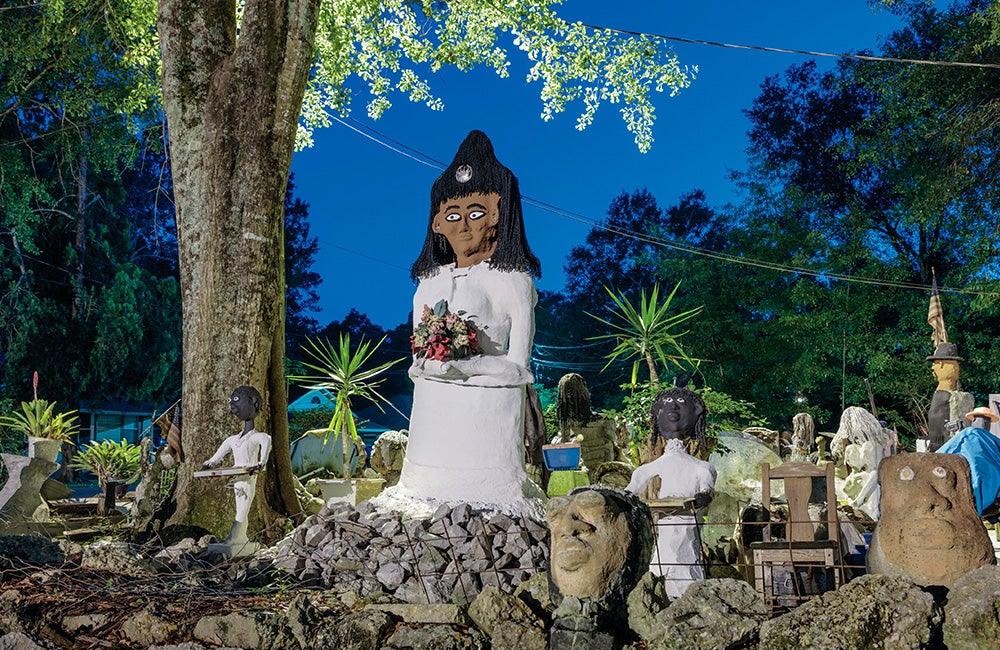First published: Winter 2016
Instead of sidewalks, an allegorical carpet-bottomed drainage ditch runs along both sides of Dr Charles Smith’s corner property in a restless residential neighbourhood of Hammond, Louisiana. A moat around “hallowed ground” with a small trestle bridge leading to the front entrance of his African American Heritage Museum and Black Veterans Archive home, it represents the Niger River. A low wall of rocks and broken concrete (one for every African American soldier killed in Vietnam) forms a water monster-guarded embankment along the “river’s” edge. Water surrounding the perimeter also recalls the swampland refuge of escaped slaves, and the concrete-sculpted, alligator-like monster represents both danger to the runaways, and protection from “slave catchers” who feared to enter. Large disembodied heads facing the street are seen throughout the encircling wall, which is also symbolic of the Mississippi River levee where 23 decapitated heads from executed slaves were displayed on poles after the 1795 Pointe Coupee conspiracy and uprising.
 The site is dominated by "Mother of Africa”, representing an African earth mother for all races, the Christian Mary and Smith’s own mother and wife
The site is dominated by "Mother of Africa”, representing an African earth mother for all races, the Christian Mary and Smith’s own mother and wife
A few metres south of the water monster, the smooth, dark, Egyptian Memorial figure sits along the embankment. Larger than life-size and wearing an asp headdress, it represents the enduring but overlooked contribution of Egypt to the legacy of African culture. When wet from frequent rain, the glistening, concrete, pharaonic sculpture almost appears to have been carved from basalt. Near the house, a (discreetly) topless sculpture of the former (and first female African American) Secretary of State Condoleezza Rice seems cast from gold. She’s a “golden girl” of modern culture, linked by latex gilding to ancient African royalty. Just inside the perimeter embankment towards the southeast corner, the Mother of Africa towers over the site in an outspread, white-washed dress.
A queen representing African cultural fertility and an earth goddess for the human race (“[I believe] that life started in Africa”) also represents a trinity of mother Marys: Smith’s own mother Bertha Mary Smith, his wife Mary and Mary of Nazareth. She wears a silver “Mother-of-Christ” radiating-crown emblem on her crest of braided hair. “Once that piece was completed, many of the young ladies in the neighbourhood started wearing their hair just like that… they grow up to be ladies… larger than life, but you’ve got to… carry yourself with the morals that go with [being] a queen.”
Passing more slave heads along the southern boundary, visitors come to a colossal male figure sitting at the opening in the embankment wall where the small bridge leads onto the property. Dressed in white with thick horizontal black stripes, the founder of Hammond, Louisiana’s “favorite slave boy”, is impossible to miss. Interred without a name or dates under a small ground marker for the “UNNAMED SLAVE BOY” a few blocks away in the Hammond family cemetery on Charles Street, the Slave of Hammond, of indeterminate age (through much of the twentieth century, adult African-American men were commonly referred to as “boys”), has been resurrected as a civic monument. Now publicly honoured and embraced as an ancestral son, Dr Smith calls him “Charles”. Smith uses black stripes on white – dark reflections of the many US flags seen throughout the site – to recall prison garb and link the incarceration of African-American males to the legacy of slave trading. Several alluringly-exposed female figures are anatomically wrapped and bound to assure chaste delivery to their New World buyers.
Set slightly back from the southwest corner, a three-meter, accidental self-portrait bust wearing a Marine Corps helmet, holds the American flag over the western border of the site. An extension of its large base, ironically emblazoned with “WE SHALL DEFEND”, the figure wears an olive-drab, v-neck uniform shirt, striped with the Pan-African colours: red (blood), green (fertile land) and black (people). Smith says: “I really in the beginning didn’t have in mind… putting me [up] there, but… a kid rolled by… and he says, ‘Hey, Mister…that you?’” and “I say, well yeah okay, that’ll be me.” Born into the segregated South in 1940, Charles Smith has titled himself with an honorary doctorate of life experience and understanding. Following his father’s death, his mother moved the family from New Orleans to Chicago in the late 1940s where, in 1955, she brought her children to open-casket services for the mutilated corpse of Emmet Till (a 14-year-old African-American boy who was lynched in Mississippi after whistling at a white woman).
This is an article extract; read the full article in Raw Vision #92




